While Punxsutawney Phil and the meteorologists work out their differing predictions for the end of winter, growers are already hard at work preparing for spring, summer and fall.January plant starts included cabbage,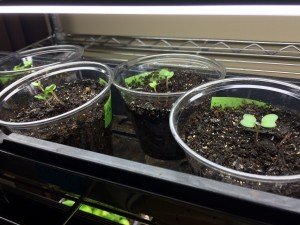 chili peppers, bell peppers and rosemary.
chili peppers, bell peppers and rosemary.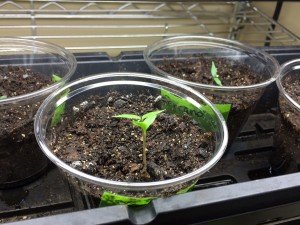 Now that February has begun, the seed starting kicks into high gear with oregano, collards and lots and lots of tomatoes with 8 varieties and a total of 38 plants this year!
Now that February has begun, the seed starting kicks into high gear with oregano, collards and lots and lots of tomatoes with 8 varieties and a total of 38 plants this year!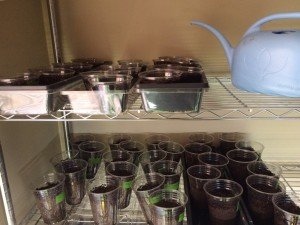 The new starts will welcome roommates in my growing nook for the cilantro and basil I grow indoors each winter. I purchased inexpensive shop lights, metal wire shelving units and florescent tubes 5 years ago so I never have to go a grey winter day without their bright colors and fresh flavors complimenting meals.
The new starts will welcome roommates in my growing nook for the cilantro and basil I grow indoors each winter. I purchased inexpensive shop lights, metal wire shelving units and florescent tubes 5 years ago so I never have to go a grey winter day without their bright colors and fresh flavors complimenting meals.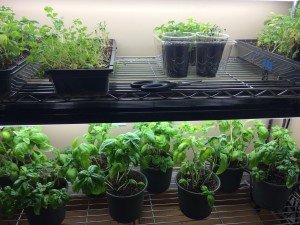 The minimal, initial investment for the equipment has more than paid for itself already and now as my garden diversifies and the number of indoor starts continue to expand each year with no additional infrastructure costs to date, I consider this money extremely well spent.Happy Spring, whenever it comes :)
The minimal, initial investment for the equipment has more than paid for itself already and now as my garden diversifies and the number of indoor starts continue to expand each year with no additional infrastructure costs to date, I consider this money extremely well spent.Happy Spring, whenever it comes :)
New Year's Resolutions (Then and Now)
For 2015 I set two gardening goals for myself - begin keeping a garden log and saving seed and I did pretty well on both of them. My 2015 garden log ended the year with 8 typed pages and containing details from pounds of tomatoes and serranos harvested to the date of the first and last blueberries. I used Word for Mac so I can keyword search in 2016 (and beyond) if I want to find when I planted the 3rd crop of edamame or when my squash and cucumbers were invaded by cucumber worms. I found I was more diligent about doing entries if I kept the document open on my second monitor at all times so when I began the 2016 garden log earlier this month detailing all the indoor starts for January, I continued with this practice.Prior to 2015, I had only saved my own cilantro/coriander seed and purchased everything else. At the end of 2015 I had saved 10 different varieties of everything from squash and chili peppers to flowers and tomatoes. My seed box, which has always been full of Baker Creek Heirloom Seeds packages is now peppered with the plain brown paper envelopes that I use for my own seed.For 2016 my two goals are saving even more of my own seed and mulching. Going from 1 to 10+ varieties that I saved seed from in 2015 is good, but I am growing over 53 annual varieties in 2016 so there is plenty of room to continue to improve in this goal.The Square Foot Gardening method I use places a heavy emphasis on compost but almost none on mulching. The SFG method recommends starting with a 33% compost mixture in the raised beds and continually adding compost as plants are removed and new plants added to each individual square foot, but no mention of covering the soil between and around plants. Soil science as well as observation have led me to understand that just as nature abhors a vacuum and will swiftly fill it, soil abhors being exposed and will cover itself with weeds if it must to protect it from the wind and the sun, allowing it to retain water better and reduce erosion.So for 2016 I will be experimenting with different types of mulches in my beds to see what works best, doesn't invite too many visiting pests and makes the plants and soil happy and healthy.Here's to getting better every year! #Kaizen
Will Work For Food
The phrases urban agriculture and urban farming answer the where and the what, but not necessarily the why of food production. Some urban growers are producing for personal use (which could include sharing their excess bounty with friends, neighbors and coworkers) while other growers are producing food as part or all of their household income stream.While these two groups take very different approaches to growing, watching Curtis Stone's Profitable Urban Farming workshop intro showed me that the personal grower can learn from some of the strategies and efficiencies of the income grower. We are both working to grow food so a little cross pollination (pardon my pun) of ideas can be beneficial.In this 42 minute video he gives an overview of his commercially successful urban farm in Kelowna, BC. For income growers, there are a lot of interesting ideas presented. He has an innovative strategy for land acquisition that is essentially OPP, other people's property. He rents portions of front, back and side yards from homeowners in his city within a 1 1/4 mile of his home to grow his produce.A very interesting strategy he uses that can be adapted for personal growers is how he categorizes crops as either "quick" or "steady". Quick crops are crops that are ready to harvest in less than 60 days. Steady crops are those "cut and come again" crops that take longer but provide a more sustained harvest. With his 5 growing plots scattered across 1 1/4 mile, he grows his quick crops in the plots closest to him, since they need to be visited more often for planting, rotation and harvest. He plants his steady crops in the furthest plots to since they only need to be harvested once or twice per week.Personal growers can adapt this concept and plant their baby greens and lettuces in the part of their garden closest to the house and plant the squash and onions in the far part of the garden since they need less regular attention.For growers looking to build or expand their business, this video is packed with information. For personal growers, there are some great tips on layout, harvesting and drip irrigation that can be implemented in home gardens.In addition to this workshop intro video, he has a lot of other videos on his YouTube channel worth perusing for both income and personal growers.
City Farm
"What if we ingeniously enriched that vacant land with waste wood products, waste food products and had a rich farm, employed local people to produce the healthy foods that community needs?" - Ken Dunn, founder of Resource Center and City FarmCity Farm is doing all of that and more! City Farm subsidizes their direct sales to the public by contracting with local restaurants wanting fresh, local produce on their menus. City Farm then picks up the restaurant's food waste to be recycled into compost to feed the rich soil that will grow more food.The images in this video capture the beauty of this little agricultural oasis against the backdrop of the Chicago skyline:For a more in depth look at how City Farm is diverting urban waste to create fresh, sustainable food for the local community:In December, City Farm began moving from it's location at 1204 N Clybourn to a new lot one block to the west. Each summer I attend a conference in Chicago for a few days in August and I can't wait to see the new farm when I am there!
Hello, My Name Is...
This year will be my fifth year as an urban food grower. It will also be my fifth attempt to create plant markers that are still legible at the end of a growing season. With 52 varieties of annuals planned in addition to the handful of perennials that live in my garden, knowing who is who can be important. This is particularly true when it comes to saving seed.In previous years I have tried cheap plastic tags labeled with sharpee, which faded after just a few short months followed by the same plastic tags using pencil after reading the graphite would weather better than ink. They did not fade quite as much or as fast as the sharpee had, but were still hard to read after a few months of sun and rain. Next up was wine corks with sharpee thinking that the porous nature of the corks would absorb the ink better than the hard plastic had but which also faded into illegibility by mid season.For this year's garden I was determined to find something more lasting and attractive for my plant markers since the majority of these varieties will be planted year after year. I spent some time researching permanent plant markers and found these copper plate markers that can be inscribed with a pen and a bit of elbow grease.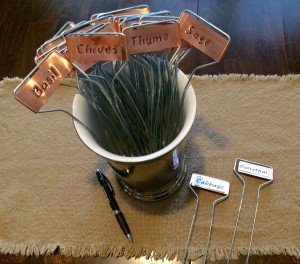 The initial cost to purchase and the time to label are certainly higher than my previous marker attempts but the end result is much more pleasing and should endure for many years to come.To inscribe the markers I printed out my varieties list in a nice, easily readable font. I laid the variety name printout over the copper plate and gently traced out the letters. I then removed the printout and used the pen to go over the letters directly on the copper plate until satisfied with the depth and thickness of the letters.
The initial cost to purchase and the time to label are certainly higher than my previous marker attempts but the end result is much more pleasing and should endure for many years to come.To inscribe the markers I printed out my varieties list in a nice, easily readable font. I laid the variety name printout over the copper plate and gently traced out the letters. I then removed the printout and used the pen to go over the letters directly on the copper plate until satisfied with the depth and thickness of the letters.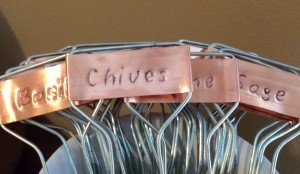 Each year my garden gets better and better #kaizen
Each year my garden gets better and better #kaizen
The Expat Starter Garden
A dear friend is moving south of the border to live on the shores of Lake Chapala, said to have the second best climate on earth, behind only Atenas, Costa Rica. She wants to start a small garden there and was looking for suggestions.All of these suggestions do very well in both containers (both patio and raised bed) and in rich garden soil, making them versatile, low maintenance choices for a first time gardener.If you are only going to grow one thing, I think basil is a great place to start. It is easy to grow, abundantly productive and can be added to almost every meal you make or have for takeout. I prefer the sweet genovese varieties.If you are only going to grow two things, then basil and cilantro are my choices. Again, easy, abundant and can add a bright taste to any dish, homemade or otherwise. For warmer climates (mine included) try a slo bolt variety.Oregano and rosemary are also low maintenance but useful and abundant herbs for a first time gardener and experienced cook.If she wants to expand beyond herbs, spinach is a great choice for novices. Leaves can be taken as needed allowing the plant to continue growing, many fresh or cooked uses and easy to grow. Again, with warmer climates, a slo bolt variety would be best.After spinach, the chili pepper of your preferred spiciness range. I favor serranos. They are very abundant producers, impart a great flavor in addition to the heat they add to dishes and can be picked green or red depending on your heat preferences. Roasting ripe ones each time you grill and freezing them means delicious roasted peppers on hand year round.And then every gardener's pride and joy, tomatoes. For many of the same reasons, I would recommend cherry type tomatoes for the small scale gardener. They produce much more abundantly than slicing tomato varieties and due to their size can be dried or roasted and frozen for year round additions to meals.With just these 7 items, incorporating bounty fresh from the garden (or preserved from the garden) year round is easy and will work into everyone's favorite dishes.
Regrowing Update
An update from last month's post on regrowing veggies I have tripled the number of green onions I am regrowing to keep up with culinary demands and have just started my first celery, another in demand veggie that I will need to add more of with another purchase or two.
I have tripled the number of green onions I am regrowing to keep up with culinary demands and have just started my first celery, another in demand veggie that I will need to add more of with another purchase or two.
Countdown to Garden 2016
Even before presents are unwrapped, the countdown is on with less than a month to go before indoor starts of cabbage, leeks and rosemary get going in the first part of January with peppers (hot and bell) just behind.So I've been making my list and checking it twice this week to see what varieties will make it into my 219 square foot of garden space for 2016.I am making heavy use of containers for herbs (and one lettuce I just couldn't resist) and also using two composted trenches in the yard to grow The Three Sisters: corn, blackeyed peas and decorative squash. I currently have 8 1x1 boxes for cucurbits, but will be adding in 3 more before spring to hold all the zucchini, squash and cucumbers on my list.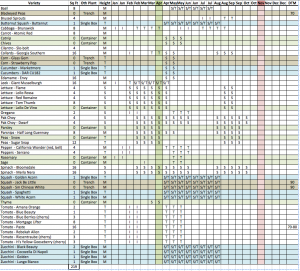 Despite planning 52 different varieties of annuals for next year, my 2016 seed order (including shipping) came in under $42. This economy was mostly due to saving more of my own seed this year than ever before and having plenty of unused 2015 seed for most of what I plan to grow next year - Square Foot Gardening makes better use of individual seeds than row gardening so more seeds are conserved for future use.
Despite planning 52 different varieties of annuals for next year, my 2016 seed order (including shipping) came in under $42. This economy was mostly due to saving more of my own seed this year than ever before and having plenty of unused 2015 seed for most of what I plan to grow next year - Square Foot Gardening makes better use of individual seeds than row gardening so more seeds are conserved for future use.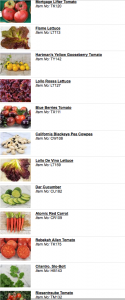 One of my splurge purchases for this year was the Slo-Bolt Cilantro. I am still drawing down the huge supply of cilantro/coriander seeds saved from my 2012 garden. They still have a high germination rate so I have been using them for both outdoor garden and microgreen plantings since then. If the slo-bolt lives up to its name, my 2012 cilantro has had its last reproductive cycle and will be only for microgreens and I will switch to saving the slo-bolt seed.Next I will start plotting out the placement of these plantings on my garden map. 2015 was my first full garden cycle in Raleigh and the biggest lesson was that maximizing light has to be a priority for north facing gardens further complicated by some tree shade. To that end, I added a height column with each plant ranked Short, Medium or Tall to plan my garden for next year. Tallest plants in to the north and shortest plants to the south has always been the rule of thumb but is now a requirement for my future garden plans which will make crop rotations a little more challenging.It is damp, but in the low-mid 70's this weekend, so I will also spend some time putting in new grids into my raised beds. I have been using kitchen string for the past few years but the cottony string only lasts one year before stretching, breaking and needing to be replaced. This year I am going to try a white nylon string that is made for outdoor use and hope it holds up better.Here's to a wonderful close to 2015 and a bright start to 2016! Happy Holidays!
One of my splurge purchases for this year was the Slo-Bolt Cilantro. I am still drawing down the huge supply of cilantro/coriander seeds saved from my 2012 garden. They still have a high germination rate so I have been using them for both outdoor garden and microgreen plantings since then. If the slo-bolt lives up to its name, my 2012 cilantro has had its last reproductive cycle and will be only for microgreens and I will switch to saving the slo-bolt seed.Next I will start plotting out the placement of these plantings on my garden map. 2015 was my first full garden cycle in Raleigh and the biggest lesson was that maximizing light has to be a priority for north facing gardens further complicated by some tree shade. To that end, I added a height column with each plant ranked Short, Medium or Tall to plan my garden for next year. Tallest plants in to the north and shortest plants to the south has always been the rule of thumb but is now a requirement for my future garden plans which will make crop rotations a little more challenging.It is damp, but in the low-mid 70's this weekend, so I will also spend some time putting in new grids into my raised beds. I have been using kitchen string for the past few years but the cottony string only lasts one year before stretching, breaking and needing to be replaced. This year I am going to try a white nylon string that is made for outdoor use and hope it holds up better.Here's to a wonderful close to 2015 and a bright start to 2016! Happy Holidays!
A New Old Fashioned Barn Raising
I was researching a local farm that I am interested in purchasing from and ran across an article about their recent BarnRaiser.us campaign to improve the sustainability and profitability of their livelihood. I was intrigued and wanted to learn more about BarnRaiser.There are so many things to love about this artisanal food crowdfunding site:
- The name is wonderfully evocative of the end goal, a community coming together to support the needs of farmers and food artisans
- The admirable mission statement is "To put a billion dollars into the hands of food innovators as they reshape a healthy food world."
- BarnRaiser fees are based solely on fully funded goals. No goal = no fee for trying
- And like the other crowdfunding sites, the farmers and artisans looking to get funded offer up little goodies for supporting them at different levels
- Projects seeking funding are listed in a gallery format with name and photo, a status bar showing how much money has been pledged and how much money and how many days are left to fund the project and, last but not least, location for the project
- According to the FAQ, Project Creators are subject to some level of identity verification
- The site is great exposure for the farmers and food artisans whether they reach their funding goals or not
Let's go raise some barns!
Following In Their Footsteps
I am fascinated with our collective "firsts" in agriculture, our earliest cultivars, our earliest domestications, our earliest preservation techniques. These first forays into plant and animal husbandry are what allowed humans to go forth and multiply, they are the stuff of our religious stories, myths and legends and their long tenure as our companions as well as their historic significance are worth honoring.My first fruit trees were figs because they are believed to be the first plants cultivated by humans and also, by no coincidence whatsoever, they are also the first recognizable tree in the Hebrew Bible (after the Tree of Life and the Tree of Knowledge).While I haven't yet turned my entire lawn from the suburban ornamental grasses that neighbors expect to see into the historic grasses and grain plants the are the root of many of our grain foods (you're welcome HOA), my fascination with the origins of ancient grains has ticked up a notch lately. To that end, I ran across this great tour of historic grains from around the world by Bob's Red Mill that was both illuminating and educational onto some know and unknown grains:
December Morning on the (Urban) Farm
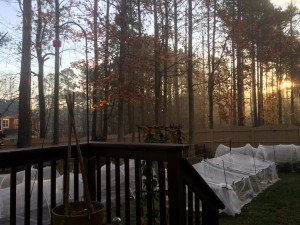 Some keep the Sabbath going to the ChurchI keep it, staying at HomeWith a Bobolink for a ChoristerAnd an Orchard, for a Dome
Some keep the Sabbath going to the ChurchI keep it, staying at HomeWith a Bobolink for a ChoristerAnd an Orchard, for a Dome
Some keep the Sabbath in SurpliceI just wear my WingsAnd instead of tolling the Bell, for Church,Our little Sexton sings.
God preaches, a noted ClergymanAnd the sermon is never long,So instead of getting to Heaven, at lastI’m going, all along. ~ Emily Dickinson
Mornings like this never fail to bring the words this poem that I loved since I was a young girl to mind. The beauty of the rising sun was rivaled by the sunset colors of the blueberry leaves all decked out in their fall colors. And the tender green leaves of the Tom Thumb lettuce growing in a container on my deck made the morning feel more like a late spring day than a warm winter one.
And the tender green leaves of the Tom Thumb lettuce growing in a container on my deck made the morning feel more like a late spring day than a warm winter one.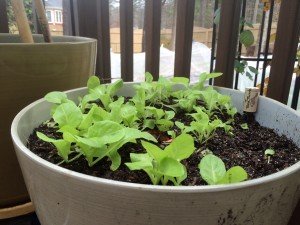 Now, if I just had that orchard dome...
Now, if I just had that orchard dome...
Favorite Things
One of my favorite gifts to give the bookworms on my holiday shopping list this year are these wonderful little bookmarks from GreenMarker.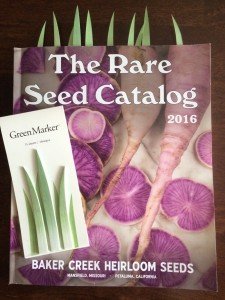 There are 75 blades in each pack so I might have enough to do my whole spring seed order ;)
There are 75 blades in each pack so I might have enough to do my whole spring seed order ;)
Trench Composting for Corn
I have never really wanted to grow corn since the small amounts I desire for home cooking are readily available at the farmer's market in season, it takes up a lot of valuable space in an already tight garden plan and it is an environmentally costly plant to grow. Corn is greedy. Really greedy.Then I promised my 8 year old that he could grow anything he wanted next year and flipping through a seed catalog he picked Strawberry Popcorn. I dutifully ordered the seeds and we were researching growing, harvesting and drying the variety online when we ran across our first glimpses of Glass Gem Corn. We marveled at the photos and videos of this varietal and were both smitten by its beautiful colors. When it appeared on the Baker Creek Heirloom cover a couple of weeks ago, I found myself suddenly preparing for two varieties of corn in spring 2016 but still didn't want corn in my garden proper.My suburban lawn is in its second year of organic management (no herbicides, pesticides or fertilizers are used) so the conundrum of what to do with the corn made me consider planting directly in the yard as a solution to the space requirements and soil depletion problems of corn. But although I don't use chemicals on the soil, that is not the same thing as having good, rich soil for growing anything. I had seen information on trench composting some time ago and decided to dig back in and learn a bit more.There are a lot of variations on trench composting from the fill it as you go style to the much more elaborate hugelkultur style installations. I opted for something closer to the style in the video below.https://www.youtube.com/watch?v=W1XmP9-RpmYI started with a trench and filled in a layer of browns. These are leaves and pine needles that have been composting for a year now. The leaves have already broken down into a rich soil structure but the pine needles take a bit longer.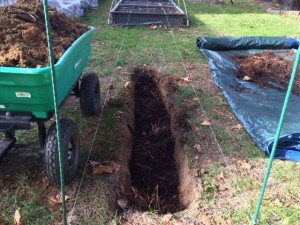 I followed the layer of browns with some rich, dark, nearly done compost from my two tumbling composters.
I followed the layer of browns with some rich, dark, nearly done compost from my two tumbling composters.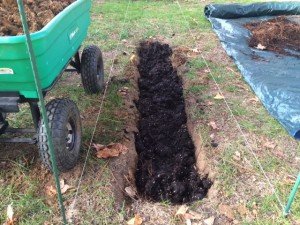 I topped the compost with another layer of the browns.
I topped the compost with another layer of the browns.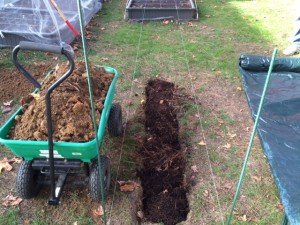 And finished it off by replacing a top layer of soil, mounding it up a bit since it will settle as the layers of browns and compost continue to biodegrade and compact.
And finished it off by replacing a top layer of soil, mounding it up a bit since it will settle as the layers of browns and compost continue to biodegrade and compact.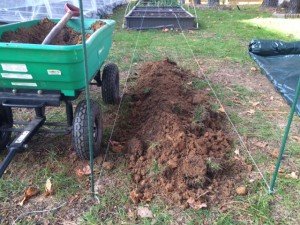 The Glass Gem Corn will be planted on either side of this trench in spring and I will need to do the same elsewhere in my yard for the Strawberry Popcorn. I hope to have a staggered planting system in years ahead where I grow on top of a trench a year and a half after it is filled with rich, organic matter that has had time to be broken down by microbial and worm activity.
The Glass Gem Corn will be planted on either side of this trench in spring and I will need to do the same elsewhere in my yard for the Strawberry Popcorn. I hope to have a staggered planting system in years ahead where I grow on top of a trench a year and a half after it is filled with rich, organic matter that has had time to be broken down by microbial and worm activity.
Winter Growing
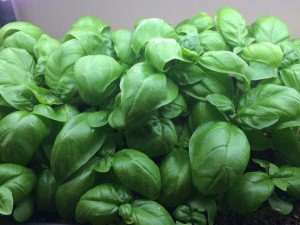 This winter there will be a lot of focus on my indoor gardens mostly because my outdoor winter garden is a bit of a bust this year. The collards and spinach I planted were just beginning to grow when an unseasonable cold-snap halted them in their tracks. I tried resowing but still don't have much of anything green going on outside. I haven't given up completely on the 3 inch tall collards that I still hope will be served on New Years, but accept that I may be buying most of my good luck meal this year instead of growing it.Right now my indoor garden consists of two trays of basil microgreens (already harvesting from the tray on the left) and 8 pots of basil that will be allowed to grow into full plants of about 8" tall and pruned a bit daily as needed for meals.
This winter there will be a lot of focus on my indoor gardens mostly because my outdoor winter garden is a bit of a bust this year. The collards and spinach I planted were just beginning to grow when an unseasonable cold-snap halted them in their tracks. I tried resowing but still don't have much of anything green going on outside. I haven't given up completely on the 3 inch tall collards that I still hope will be served on New Years, but accept that I may be buying most of my good luck meal this year instead of growing it.Right now my indoor garden consists of two trays of basil microgreens (already harvesting from the tray on the left) and 8 pots of basil that will be allowed to grow into full plants of about 8" tall and pruned a bit daily as needed for meals.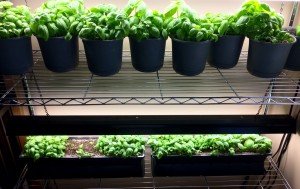 I will be starting another 3 trays of cilantro microgreens this weekend and will do various other types of microgreens (arugula, mustard and red cabbage) off and on all winter to add some homegrown flavor and crunch to winter meals.If you are considering indoor growing, microgreens have a lot going for them. They have a very quick turn around, usually only 2-4 weeks from beginning to end which is basically instant gratification in the gardening world. And due to their fast germination to harvest cycle, they aren't usually around long enough for pests and diseases to become an issue.These little plants really do have some powerful flavor, often even more than their adult versions and growing research from reputable sources is showing that some of them are packed with up to 5x the vitamins and carotenoids found in the adult versions of the same plants.So whether or not my outdoor garden takes off with this wonderfully sunny and warm week we are having, I will be posting (and eating) fresh all winter long.
I will be starting another 3 trays of cilantro microgreens this weekend and will do various other types of microgreens (arugula, mustard and red cabbage) off and on all winter to add some homegrown flavor and crunch to winter meals.If you are considering indoor growing, microgreens have a lot going for them. They have a very quick turn around, usually only 2-4 weeks from beginning to end which is basically instant gratification in the gardening world. And due to their fast germination to harvest cycle, they aren't usually around long enough for pests and diseases to become an issue.These little plants really do have some powerful flavor, often even more than their adult versions and growing research from reputable sources is showing that some of them are packed with up to 5x the vitamins and carotenoids found in the adult versions of the same plants.So whether or not my outdoor garden takes off with this wonderfully sunny and warm week we are having, I will be posting (and eating) fresh all winter long.
Store Bought Reboot - Regrowing Veggies
Here at NearlyHomeGrown, food scraps usually end up being frozen for future vegetable and/or chicken stocks or composted to feed the next generation of growing food. But I have been interested in the regrowing veggies craze and finally had the perfect reason to try it.The latest shiitake flush resulted in 7.7 oz of fresh mushrooms and they have been going into almost every meal in one way or another, but especially into homemade ramen noodle soup where they are a headliner ingredient. One of the other ingredients, the scallions, have been something of a philosophical splurge for this autumnal meal. They are store bought, out-of-season produce that I could live without but really didn't want to because of the flavor and color they add to the dish...and voila! The perfect vegetable to try regrowing!
One of the other ingredients, the scallions, have been something of a philosophical splurge for this autumnal meal. They are store bought, out-of-season produce that I could live without but really didn't want to because of the flavor and color they add to the dish...and voila! The perfect vegetable to try regrowing!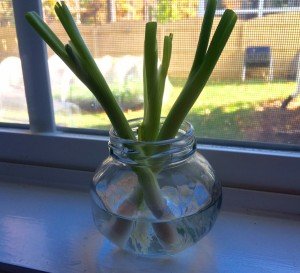 The green onion ends were pulled from the cooking scrap pile destined for stock making and put into a clear jar with fresh water and placed in a sunny window. The water will need to be changed every other day between now and spring when I will try planting them in my outdoor garden. In the meantime I can continue to steal the green tops for ramen soup and other dishes while keeping the root alive and growing.
The green onion ends were pulled from the cooking scrap pile destined for stock making and put into a clear jar with fresh water and placed in a sunny window. The water will need to be changed every other day between now and spring when I will try planting them in my outdoor garden. In the meantime I can continue to steal the green tops for ramen soup and other dishes while keeping the root alive and growing.
Glass Gem Corn
 It's not often that a packet of seeds is so exciting that I cannot wait until spring to open the flap and take a peek inside. Glass Gem corn is a clear exception!The Glass Gem heirloom corn variety hit the homegrown stage a few years ago and has been offered only on a wait-list basis from very limited outlets until now. So when I saw the cover of the 2016 Baker Creek Heirloom Seeds catalog I assumed they were just highlighting a very photogenic variety for the cover. When I discovered they were actually carrying the seed, I didn't hesitate and am now planning where to plant the star of my 2016 garden!
It's not often that a packet of seeds is so exciting that I cannot wait until spring to open the flap and take a peek inside. Glass Gem corn is a clear exception!The Glass Gem heirloom corn variety hit the homegrown stage a few years ago and has been offered only on a wait-list basis from very limited outlets until now. So when I saw the cover of the 2016 Baker Creek Heirloom Seeds catalog I assumed they were just highlighting a very photogenic variety for the cover. When I discovered they were actually carrying the seed, I didn't hesitate and am now planning where to plant the star of my 2016 garden!
V Keeping Like Why It Magnum
This has to be one the most entertaining examples of auto-generated closed captioning on YouTube!Whether or not you are interested in top bar beekeeping, click the CC button and enjoy:
Quest For Fire
My tomatoes were troopers this year holding onto green romas, blue beauties and red delicious globes into early November, but I gave up and pulled the remainders two weeks ago just so I could begin cleaning the beds and preparing them for winter before heading off to a week's worth of meeting in San Diego last week.This weekend's task was to pull the rest of the serranos off before 3 consecutive nights of freezing or below temperatures hit them. My final harvest ended up being 1lb, 5oz of beautiful peppers that will warm dishes from now until next year. All were cleaned and vaccu-sealed before being frozen except for a few that will go into the Thanksgiving cornbread later this week.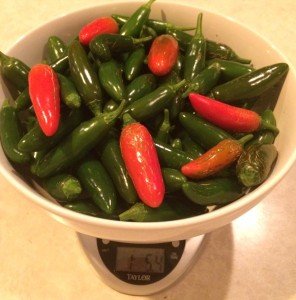 On another pepper note, a friend has some seeds that he will be sharing with me from his home country of El Salvador. I am keenly interested in growing them out next year since he doesn't know the name of them in either his native tongue or English. For now I am thinking of them as Mystery Pepper and what a fun mystery to solve!
On another pepper note, a friend has some seeds that he will be sharing with me from his home country of El Salvador. I am keenly interested in growing them out next year since he doesn't know the name of them in either his native tongue or English. For now I am thinking of them as Mystery Pepper and what a fun mystery to solve!
Growing Sustainability - Part 2
In Growing Sustainability - Part 1 I lauded the War Commission Gardens and Victory Gardens for what they grew, a lot of food and a more self-sufficient citizenry. At their height, over 20,000,000 Victory Gardens dotted the American landscape and in 1944, they were producing 40% of all the vegetables grown in the US. These small scale but widespread gardens and orchards contributed to the food landscape in many subtle ways beyond just the food produced on them. A diversity of growers and a diversity of what is grown seems to go hand-in-hand.This startling illustration by the Rural Advancement Foundation International-USA depicts the realities of our dwindling agricultural biodiversity with a sampling of the commercially available varieties of 10 commonly grown vegetable seeds from seed houses in 1903 at the top of the chart and the dramatic reduction in varieties of those same vegetables at the National Center for Genetic Resources Preservation just 80 years later.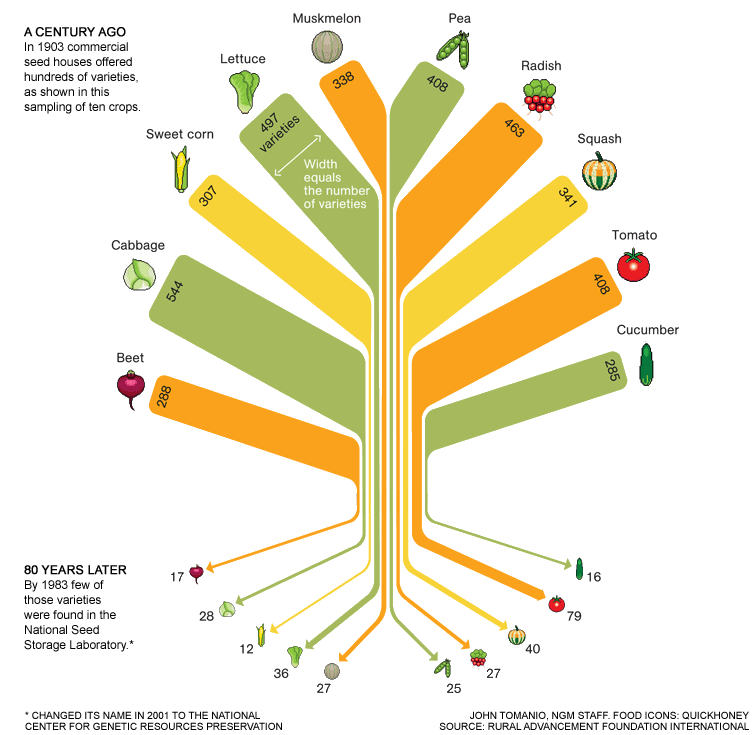 And it is not just the 1o varieties shown above that are at risk - this article by National Geographic puts the estimated diversity loss of all historic fruits and vegetables for the US at 90% while this Food and Agriculture Organization of the United Nations article puts the total global decrease of plant diversity at 75% in the last century.But there is good news in the What's For Dinner in 2025 discussion as well. Recessions spur backyard growing in a big way because growing your own food is cheaper than buying it. And this last recession happened in the age of the internet! How to plant, grow and harvest videos populate YouTube and sites like Garden Girl TV. Online seed houses for heirloom and open pollinated seeds have exploded in number and serve to connect the growers to a growing variety of available seeds. Two of my favorites are Baker Creek Heirloom Seeds and Seed Savers Exchange. Countless rural and urban farmers have blogs and vlogs, sharing their successes and failures and creating online communities that are (excuse the pun) growing.Whether the online/rural/suburban/urban agricultural movement of people growing food where ever they live will be able to sustain itself over the long haul is anyone's guess. So a further bit of good news for future agricultural diversity is that Cary Fowler, along with the Consultative Group on International Agricultural Research (CGIAR) created the Svalbard Global Seed Vault to serve as a salt mine style back up of seeds from gene banks all over the world.Every minute of Cary's charming, engaging, sometimes scary* and ultimately uplifting 2009 TED Talk is worth watching!* At the 8:30 mark he talks about the the extremely limited time (2 breeding cycles) that plant breeders have to get corn ready for the climate of 2030. In the context of today's GMO headlines, it is easy to forget that injecting genes into a food crop does not make "food". It makes a plant organism that still has to grow to sexual maturity, be crossed with another plant to even get the first round of seed to test.
And it is not just the 1o varieties shown above that are at risk - this article by National Geographic puts the estimated diversity loss of all historic fruits and vegetables for the US at 90% while this Food and Agriculture Organization of the United Nations article puts the total global decrease of plant diversity at 75% in the last century.But there is good news in the What's For Dinner in 2025 discussion as well. Recessions spur backyard growing in a big way because growing your own food is cheaper than buying it. And this last recession happened in the age of the internet! How to plant, grow and harvest videos populate YouTube and sites like Garden Girl TV. Online seed houses for heirloom and open pollinated seeds have exploded in number and serve to connect the growers to a growing variety of available seeds. Two of my favorites are Baker Creek Heirloom Seeds and Seed Savers Exchange. Countless rural and urban farmers have blogs and vlogs, sharing their successes and failures and creating online communities that are (excuse the pun) growing.Whether the online/rural/suburban/urban agricultural movement of people growing food where ever they live will be able to sustain itself over the long haul is anyone's guess. So a further bit of good news for future agricultural diversity is that Cary Fowler, along with the Consultative Group on International Agricultural Research (CGIAR) created the Svalbard Global Seed Vault to serve as a salt mine style back up of seeds from gene banks all over the world.Every minute of Cary's charming, engaging, sometimes scary* and ultimately uplifting 2009 TED Talk is worth watching!* At the 8:30 mark he talks about the the extremely limited time (2 breeding cycles) that plant breeders have to get corn ready for the climate of 2030. In the context of today's GMO headlines, it is easy to forget that injecting genes into a food crop does not make "food". It makes a plant organism that still has to grow to sexual maturity, be crossed with another plant to even get the first round of seed to test.
Umami in Progress
Oh sure, we can call it my shiitake block from 100th Monkey Mushroom Farm, but fresh, delicious umami in progress is what it really is and it is a bumper crop this time!